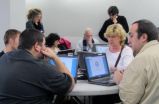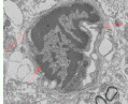(Press-News.org) As sea ice begins to melt back toward its late September minimum, it is being watched as never before. Scientists have put sensors on and under ice in the Beaufort Sea for an unprecedented campaign to monitor the summer melt.
The international effort hopes to figure out the physics of the ice edge in order to better understand and predict open water in Arctic seas.
"This has never been done at this level, over such a large area and for such a long period of time," said principal investigator Craig Lee, an oceanographer at the University of Washington's Applied Physics Laboratory. "We're really trying to resolve the physics over the course of an entire melt season."
The project is funded by the U.S. Office of Naval Research. It includes scientists from the Naval Postgraduate School, the Naval Research Laboratory, Cambridge University, Yale University, Laboratoire d'Oceanographie de Villefranche, Woods Hole Oceanographic Institution, the British Antarctic Survey, the Scottish Association for Marine Science and the Korean Polar Research Institute.
Over the next months, the campaign will look at whether the processes that drive sea ice melt will change with increasing open water to the south. For example, open water absorbs more solar radiation, which can lead to more ice melt. Open water also exposes the ocean to wind and waves, which could lead to more mixing that would bring warmer, deeper water up into contact with the ice.
Observations will show how much the open water allows surface waves to grow and break up the ice, or how winds blowing across open water or broken ice could churn up the water lower down. They also will study how deep the sun's heat penetrates, how weather and currents affect the ice, and what all this means for the growth of tiny plants and animals living in the ice.
"As there is more and more open water in the summer, the processes that control the evolution of the sea ice are changing," said Luc Rainville, an oceanographer at the UW Applied Physics Laboratory.
"Increased open water likely means more wind-driven mixing," Rainville said. "Similarly surface waves will be able to travel further in open water, gaining height and power. Once these waves meet the ice they contribute to breaking the ice edge."
The study's focus is the marginal ice zone, the region between the solid ice and the open water, which is just now beginning to form along the coast of northern Alaska and Canada.
In March, when the ice was thick enough to land aircraft, researchers installed four groups of sensors on the ice in a line that stretched nearly 200 miles to the north. Each site includes instruments to measure the atmosphere, ice and ocean. The line is designed to continuously measure the moving target of the marginal ice zone, with southern instruments melting out and the northern ones taking their place. Ocean sensors that move up and down will measure conditions under the ice.
In late July, after the ice edge recedes to expose the first open water along Alaska's north coast, researchers will release four robotic gliders. These gliders, developed by the UW Applied Physics Laboratory, will navigate using GPS in open water and from acoustic beacons suspended from the ice when under ice. When a glider pops up to the surface, researchers can download the data and send new commands from shore – for example, direct gliders to monitor the effects of a big incoming storm, or investigate a region that's melting quickly. Another instrument developed at the UW, the SWIFT float, will take precise measurements of surface waves.
Lee will join the Korean icebreaker in August to place a fifth set of instruments and to study how chemistry and temperature affect microscopic marine organisms living in the ice.
Meanwhile, a team from the University of Miami is taking high-resolution satellite pictures of the ice floes that researchers will combine with the other observations.
"This field program will provide unique insight into the processes driving the summer melt of Arctic ice," Lee said. "It's the automation and unprecedented collaboration that allows us to be out there for the entire season," he said. "You couldn't afford to be out there at this intensity, for this length of time, any other way."
INFORMATION:
For more information, contact Lee at 206-685-7656 and craig@apl.washington.edu or Rainville at 206-685-4058 and rainville@apl.washington.edu.
Lee will be out of town July 28 through Aug. 25 and available via email.
Project website: http://www.apl.washington.edu/miz
Research video: http://youtu.be/a_nbMdhS0qE
Tracking the breakup of Arctic summer sea ice
2014-07-16
ELSE PRESS RELEASES FROM THIS DATE:
Breast cancer: DMP is largely consistent with guidelines
2014-07-16
On 16 July 2014 the German Institute for Quality and Efficiency in Health Care (IQWiG) published the results of a literature search for evidence-based clinical practice guidelines on the treatment of people with breast cancer. The aim of the report is to identify those recommendations from current guidelines of high methodological quality that may be relevant for the planned revision of the disease management programme (DMP). According to the results of the report, there is no compelling need for revision of any part of the DMP. However, IQWiG identified some aspects that ...
Self-assembling nanoparticle could improve MRI scanning for cancer diagnosis
2014-07-16
Scientists have designed a new self-assembling nanoparticle that targets tumours, to help doctors diagnose cancer earlier.
The new nanoparticle, developed by researchers at Imperial College London, boosts the effectiveness of Magnetic Resonance Imaging (MRI) scanning by specifically seeking out receptors that are found in cancerous cells.
The nanoparticle is coated with a special protein, which looks for specific signals given off by tumours, and when it finds a tumour it begins to interact with the cancerous cells. This interaction strips off the protein coating, ...
Improving tumour radiation therapy: When basic ions break DNA down
2014-07-16
Scientists now have a better understanding of how short DNA strands decompose in microseconds. A European team found new fragmentation pathways that occur universally when DNA strands are exposed to metal ions from a family of alkaline and alkaline earth elements. These ions tend to replace protons in the DNA backbone and at the same time induce a reactive conformation leading more readily to fragmentation. These findings by Andreas Piekarczyk, from the University of Iceland, and colleagues have been published in a study in EPJ D. They could contribute to optimising cancerous ...
Researchers advance understanding in immune response to infectious disease
2014-07-16
University of Leicester researchers have released evidence substantiating an unexpected dual role of an important component of the immune system.
Findings by researchers at the University's Department of Infection, Immunity and Inflammation – including three PhD graduates – are published in a paper for the journal 'Medical Microbiology and Immunology'.
The paper presents significant new findings about the protein properdin – an important part of the immune system. It is a positive regulator in the alternative pathway of complement activation – which means it plays a ...
What increases the neuronal plasticity of endogenous NSCs after focal cerebral ischemia?
2014-07-16
Stem cells can substitute the lost cells after central nervous system injury, decrease nervous tissue damage and promote neurofunctional recovery. Many brain injury models, including middle cerebral artery occlusion and traumatic brain injury models, have confirmed that neural stem cells (NSCs) can migrate from subventricular zone to injured cerebral cortex. But the mechanism underlying activation of endogenous NSCs in the ischemic brain remains unclear. Dr. Hyung-Seok Kim, Chonnam National University Medical School, Korea and his team revealed that NSCs were activated ...
Age-related changes in lateral ventricular width and periventricular white matter by DTI
2014-07-16
Ventricular enlargement has been suggested as a structural biomarker for normal aging and progression of some illnesses, such as Alzheimer's disease. However, the question of how this structural change in the brain in normal elderly affects change of white matters remains a topic of interest and concern. Dr. Sang Seok Yeo, College of Medicine, Yeungnam University, Republic of Korea, and his team performed a diffusion tensor imaging (DTI) study to investigate the question. They detected four regions of interest in the periventricular white matter of 60 normal subjected aged ...
Does intravenous transplantation of BMSCs promote neural regeneration after TBI?
2014-07-16
The brain has a low renewable capacity for self-repair and generation of new functional neurons in the treatment of trauma, inflammation and cerebral diseases. Cytotherapy is one option to regenerate central nervous system that aim at replacing the functional depleted cells due to traumatic brain injury (TBI). Bone marrow mesenchymal stem cells (BMSCs) are also considered a candidate for cytotherapy because they can differentiate into neurons/nerve cells, pass across blood-brain barrier, migrate into the injured region, secrete neurotrophic factor, and provide microenvironment ...
Cooperation among humans, a question of age
2014-07-16
This news release is available in Spanish.
The new research paper, which reports on one of the first experimental studies in the world to analyze how cooperative attitudes evolve in different age ranges, was written by the professors from the OpenSystems research group of the Department Fundamental Physics at the Universidad de Barcelona (UB), Josep Perelló and Mario Gutiérrez-Roig, Anxo Sánchez, of the Complex Systems Interdisciplinary Group (Grupo Interdisciplinar de Sistemas Complejos - GISC) of the Mathematics Department at the Universidad Carlos III de ...
Zhichan decoction increases dopaminergic neurons from transplanted NSCs in PD
2014-07-16
There is an increasing interest in Parkinson's disease (PD) treatment by increasing dopamine content and reducing dopaminergic metabolites in the brain. Xuming Yang, Shanghai Municipal Hospital of Traditional Chinese Medicine, China and his team detected dopamine content and dopaminergic metabolites in the midbrain of PD rats, which were treated by neural stem cell (NSC) transplantation and Zhichan decoction administration, using high-performance liquid chromatography, and determined global optimization of dihydroxyphenylacetic acid and homovanillic acid levels using genetic ...
Chrysophanol attenuates injury to hippocampal neurons in lead-exposed neonatal mice
2014-07-16
Previous studies have shown that chrysophanol protects against learning and memory impairments in lead-exposed adult mice. Ji Zhang, Hebei North University, China, proposed a hypothesis that chrysophanol can alleviate learning and memory dysfunction and hippocampal injury in lead-exposed neonatal mice. Results showed that chrysophanol alleviated hippocampal neuronal cytoplasmic edema, promoted mitochondrial crista fusion, significantly improved learning and memory abilities, decreased lead content in blood, brain, heart, spleen, liver and kidney, increased superoxide dismutase ...

